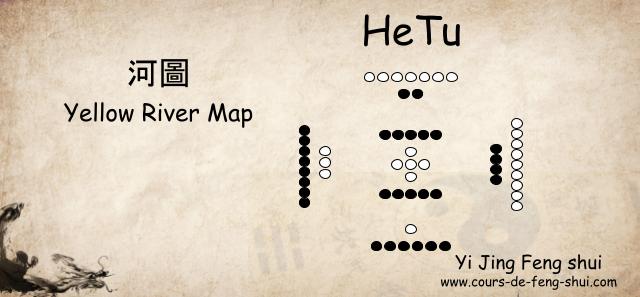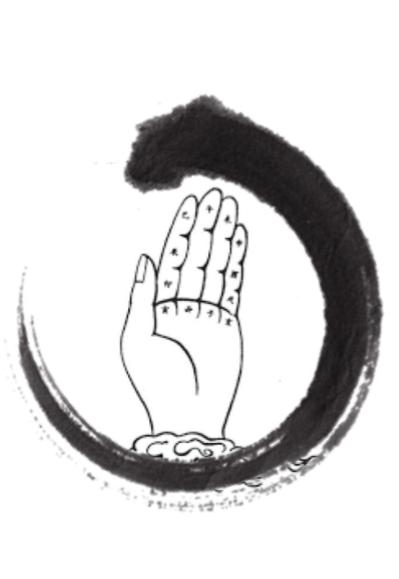
The Hetu, the map of the Yellow River, is an ancient diagram of Chinese cosmology, linked to FuXi, a character in mythology and founder of Chinese civilization.

The HeTu cosmological diagram is used to explain the correlation of the trigrams and hexagrams of the I Ching. Hetu is also used as a basis in many Feng Shui formulas.
HeTu thus represents one of the main basic systems of Chinese metaphysics, derived from the distribution of Yin and Yang, it integrates the distribution of Qi with Yin Yang and the 5 elements with numbers and directions.
Origin of the diagram
Legend has it that a Dragon Horse brought Fu Xi a diagram which gave birth to HeTu.
The Hetu diagram is already mentioned in the I Ching. Under the Han dynasty, there is also mentioned the legend of a Dragon Horse (longma 龍馬) which emerged from the Yellow River carrying on its back a card with the shape of the eight trigrams. The diagram on the horse’s back was the map of the river which was fixed by the mythological Fu Xi 伏羲 and was preserved in the form of the eight trigrams.

Etymology
In Chinese He Tu is written with the two ideograms following 河圖 and is pronounced Hétú.
河 Hé means river in Chinese and 圖 Tú means map.
HeTu and Yin Yang
A combination of white dots and black dots at the top, bottom, left, right and center.
- The white dots represent Yang and are associated with Heaven.
- The black dots represent Yin and are associated with Earth.

HeTu and the 5 elements
- 1 and 6: 1 (Yang) and 6 (Yin) form the Water element.
- 2 and 7: 7 (Yang) and 2 (Yin) form the Fire element.
- 3 and 8: 3 (Yang) and 8 (Yin) form the Wood element.
- 4 and 9: 9 (Yang) and 4 (Yin) form the Metal element.
- 5 and 10: 5 (Yang) and 10 (Yin) form the Earth element.
HeTu and numbers
The He Tu diagram has 10 numbers from 1 to 10.
The numbers are grouped in pairs, an even number and an odd number: 1 and 6; 2 and 7; 3 and 8; 4 and 9; 5 and 10. The distance between the numbers in each pair is always 5, which is also in the center.
- The five odd numbers 1, 3, 5, 7, 9 are Yang.
- The five even numbers 2, 4, 6, 8, 10 are Yin.
He Tu and directions
The directions of HeTu
- 1 and 6: 1 (Yang) and 6 (Yin) in the North.
- 2 and 7: 7 (Yang) and 2 (Yin) in the South.
- 3 and 8: 3 (Yang) and 8 (Yin) in the East.
- 4 and 9: 9 (Yang) and 4 (Yin) in the West.
- 5 and 10: 5 (Yang) and 10 (Yin) in the center.

The time cycle of He Tu
The cycle of time associated with He Tu is called 五子運 Wu Zi Yun, the cycle of the 5 Rats.
This cycle uses the sixty combinations of the terrestrial branches and the celestial trunks of the sexagesimal cycle.
Ten-year cycle Jia zi Yun(甲子運) Water element, from 1984 to 1995
- 甲子, 乙丑, 丙寅, 丁卯, 戊辰, 己巳, 庚午, 辛未, 壬申, 癸酉, 甲戌, 乙亥
Ten-year cycle Bing zi (丙子運) Fire element, from 1996 to 2007
- 丙子, 丁丑, 戊寅, 己卯, 庚辰, 辛已, 壬午, 癸未, 甲申, 乙酉, 丙戌, 丁亥
Ten-year cycle Wu zi (戊子運) element Wood, from 2008 to 2019
- 戊子, 己丑, 庚寅, 辛卯, 壬辰, 癸巳, 甲午, 乙未, 丙申,丁酉, 戊戌, 己亥
Ten-year cycle Geng zi (庚子運) element Metal, from 2020 to 2031
- 庚子, 辛丑, 壬寅, 癸卯, 甲辰, 乙巳, 丙午, 丁未, 戊申, 己酉, 庚戌, 辛亥
Ten-year cycle Ren zi (壬子運) element Earth, from 2032 to 2043
- 壬子, 癸丑, 甲寅, 乙卯, 丙辰, 丁已, 戊午, 己未, 庚申, 辛酉, 壬戌, 癸亥